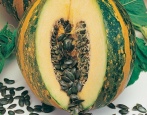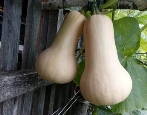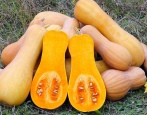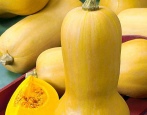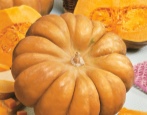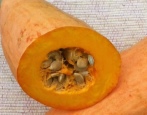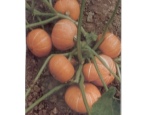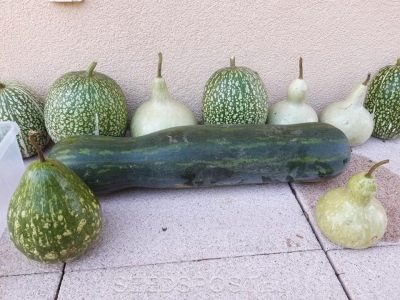
- Authors: Maksimov S.V., Klimenko N.N., Bykovsky Yu.A.
- Name synonyms: Semeynaya
- Year of approval: 2017
- Growth type: powerful
- Leaf color: green with white spot
- The form: cylindrical with a short medium neck and bend
- Weight, kg: 8.5-16 (maximum - 35)
- Coloration: dark green
- Color of the pulp: orange
- Pulp (consistency): crispy, dense, medium juiciness
Family pumpkin is a nutmeg variety bred by Russian breeders and approved for use in 2017. This variety is quite popular in the circles of Russian summer residents. In this article, the reader will learn about all the features of the Family Pumpkin.
Description of the variety
The main advantages of the variety are drought resistance and resistance to adverse weather conditions. And also gardeners note the long shelf life of the vegetable, which is up to 90 days. It is important to clarify some of the disadvantages of the variety, namely: demanding watering, and the need to thin out seedlings.
Characteristics of the appearance of plants and fruits
The plant is distinguished by long lashes, vigorous growth type, large green leaves with white spots. The fruits develop cylindrical in shape with a short neck and bend, their average weight is 8.5-16 kg, and the maximum possible weight is 35 kg. The pumpkin is dark green in color with orange pulp and blue-gray seeds.
Purpose and taste
Family pumpkin has excellent taste and can be used for any culinary purposes. Its pulp is crispy, dense, juicy, delicious mashed potatoes, muffins, cereals, soups are obtained from it.
Ripening terms
From the beginning of germination to harvest, 130-140 days pass, which is typical for varieties with a late ripening period. Harvesting takes place in August-October. It is important to harvest the pumpkin only after they are fully ripe - the peel of such a vegetable is dense and shiny, and the stalk is dry. Do not delay the collection, as you may not be in time before the onset of frost. If because of this it was necessary to collect the fruits before reaching the stage of absolute maturity, then they are placed in a warm place so that they ripen to the end. Ripe pumpkins are stored in a dry, cold room, but so that frost does not penetrate there, otherwise the vegetables will begin to rot.
Yield
On average, the Family variety yields 1.8-3.8 kg of yield per square meter.
Growing and caring
Sowing for seedlings is carried out in April-May, planting of seedlings in a summer cottage - in May-June. If the seeds are planted immediately in open ground, then it is better to do this between May and June, depending on the climatic conditions in which the crop is grown. Sowing is carried out according to the scheme 100x150 cm.
Fertile soil is suitable for growing this pumpkin, and the garden must be illuminated by the sun. Weeding is an important step in plant care. Weeds are removed systematically, as soon as they become visible above the ground. The procedure is carried out when the bushes have already grown and large leaves are closed.
Watering should be frequent, as it is a moisture-loving variety. The plant needs to be watered regularly during the growing period, then the frequency of moisture can be reduced, but the volume of water at the same time increased. Particular attention should be paid to watering during the development of shoots, flowering, and the beginning of fruit formation. Gardeners recommend root watering. You can dig grooves around the bushes and pour water there. When the fruits almost reach their maximum size, watering is stopped.
Top dressing will be required two times: before the beginning of the flowering period and after the formation of the first ovaries.It is important that the fertilizer is based on potassium, and ash infusion is also suitable as an additional nutrition.
Disease and pest resistance
The family pumpkin does not tolerate high humidity, and therefore is often affected by fungal diseases and leaf mosaics. And also this variety can become a victim of root rot and spotting. To prevent these ailments, it is recommended to loosen the soil after each wetting, and also to avoid crowding of plants, especially if the crop is grown in a greenhouse.
The melon aphid becomes a frequent enemy of this variety. To combat this pest, it is allowed to use purchased insecticides or folk remedies, but in the second case, more treatments will be needed, and the effect will not appear immediately.
